目录
解决方式一:使用自定义结果集映射resultMap解决上述问题(级联属性):
解决方式二:在resulMap中使用association标签定义多对一映射关系
介绍
最近学习了MyBaits框架,来记录一下我的学习体会。
首先MyBatis是持久层的一个框架,他封装了JDBC,几乎避免了手写JDBC的绝大部分代码,可以避免那些重复而繁多的JDBC代码。
MyBatis框架=mybatis核心jar包+配置文件,两个结合一起工作。
配置文件分为 核心配置文件 和 映射文件。
核心配置文件(mybatis-config.xml):配置连接数据库的信息以及MyBatis的全局配置信息
映射文件(XXXMaper.xml):主要写sql语句,一个操作数据库表的Mapper接口,就对应一个映射文件。
mybatis核心配置文件:
<?xml version="1.0" encoding="UTF-8" ?>
<!DOCTYPE configuration
PUBLIC "-//mybatis.org//DTD Config 3.0//EN"
"http://mybatis.org/dtd/mybatis-3-config.dtd">
<configuration>
<!--Mybatis的核心配置文件中的标签的顺序
(properties?,settings?,typeAliases?,typeHandlers?,
objectFactory?,objectWrapperFactory?,reflectorFactory?,plugins?,
environments?,databaseIdProvider?,mappers?)".-->
<!--引入properties文件,
可能会引入多个,所以配置文件中的如username键可能会一样,所以在前面加上jdbc.username用来标识-->
<properties resource="jdbc.properties"/>
<!--typeAliases:可以定义类型的别名-->
<typeAliases>
<!--类型的别名,这样在其他地方用用到com.lin.mybatis.bean.User就可以用User代替,而不用写那么长的全类名,
可以理解为为User是一个变量,而com.lin.mybatis.bean.User是变量值.
alias不写,默认就是以类名且忽略大小写为别名-->
<!-- <typeAlias type="com.lin.mybatis.bean.User" alias="User"/>-->
<!--用的比较多,package:可以为这个包下的全部类起别名,且就是以类名且忽略大小写为别名-->
<package name="com.lin.mybatis.bean"/>
</typeAliases>
<!--
environments:设置多个连接数据库的环境
属性:default指明默认使用的连接数据库的环境
-->
<environments default="development">
<!--
environment:设置具体某个连接数据库的环境
id属性:唯一标识连接数据库的环境
-->
<environment id="development">
<!--
transactionManager:设置事务管理方式
属性:
type:设置事务管理方式,type="JDBC|MANAGED"
type="JDBC":设置当前环境的事务管理方式为原生的JDBC,事务的提交或回滚都必须手动处理
type="MANAGED":设置事务被管理,例如spring中的AOP
-->
<transactionManager type="JDBC"/>
<!--
dataSource:设置数据源
属性:
type:设置数据源的类型,type="POOLED|UNPOOLED|JNDI"
type="POOLED":使用数据库连接池,即会将创建的连接进行缓存,下次使用可以从缓存中直接获取,不需要重新创建
type="UNPOOLED":不使用数据库连接池,即每次使用连接都需要重新创建
type="JNDI":调用上下文中的数据源
-->
<dataSource type="POOLED">
<!--设置连接数据库的四要素, ${key值}可以读取引入的properties文件中key对应的value值-->
<property name="driver" value="${jdbc.driver}"/>
<property name="url" value="${jdbc.url}"/>
<property name="username" value="${jdbc.username}"/>
<property name="password" value="${jdbc.password}"/>
</dataSource>
</environment>
<!--用于测试的数据库连接环境-->
<environment id="test">
<transactionManager type="JDBC"/>
<dataSource type="POOLED">
<property name="driver" value="com.mysql.jdbc.Driver"/>
<property name="url" value="jdbc:mysql://localhost:3306/MyBatis"/>
<property name="username" value="root"/>
<property name="password" value="001219"/>
</dataSource>
</environment>
</environments>
<!--
引入映射文件
一个操作表的Mapper就对应一个映射文件,平时开发中会有很多映射文件,这样就得写很多Mapper标签.
我们可以像上面的以包的形式引入映射文件
-->
<mappers>
<!-- <mapper resource="./mappers/UserMapper.xml"/>-->
<!--这样就可以一次性将com.lin.mybatis.mapper包下的所有映射文件都引入进来了.
两个要求:
Mapper接口所在的包要和映射文件所在的包一致(包名一样)
Mapper接口名要和映射文件名一致,
届时可以通过Mapper接口的全类名找到对应的映射文件。
-->
<package name="com.lin.mybatis.mapper"/>
</mappers>
</configuration>映射文件:
<?xml version="1.0" encoding="UTF-8" ?>
<!DOCTYPE mapper
PUBLIC "-//mybatis.org//DTD Mapper 3.0//EN"
"http://mybatis.org/dtd/mybatis-3-mapper.dtd">
<mapper namespace="对应Mapper接口的全类名">
<select id="Mapper接口中的方法名">
select * from t_user
</select>
</mapper>mybatis执行原理
置文当我们调用Mapper接口中的方法时,Mybatis会找到核心配置文件,读取映射文件,然后找到当前Mapper接口对应的映射文件,然后根据方法名在映射文件中定位到唯一的sql语句进行执行。
1.我们在Mapper接口中定义好操作数据库表的方法,如:getUserByUserName(String username)
/**
*
* 操作数据库中User表的Mapper,相当于之前我们学的Dao接口。
* 现在不用写实现类,MyBatis底层会使用代理模式创建Mapper接口的实现类对象然后返回,
* 我们直接使用这个实现类对象调用接口中的方法即可,他会自动去找映射文件中对应的sql语句执行。
*
* @author shkstart
* @create 2022-05-25 16:26
*/
public interface UserMapper {
/**
* 根据用户名查找用户信息
* @return
*/
User getUserByUserName(String username);
}2.Mapper对应的映射文件UserMapper.xml
<mapper namespace="com.lin.mybatis.mapper.UserMapper">
<!--User getUserByUserName(String username);-->
<select id="getUserByUserName" resultType="User">
select * from t_user where name = #{username}
</select>
</mapper>3.调用Mapper接口中的方法
@Test
public void testGetUserByUserName() throws IOException {
InputStream is = Resources.getResourceAsStream("mybatis-config.xml");
UserMapper userMapper1 = new SqlSessionFactoryBuilder().build(is)
.openSession(true).getMapper(UserMapper.class);
// "张三"就是sql语句的参数
User user = userMapper.getUserByUserName("张三");
System.out.println(user);
}mybatis获取参数的两种方式#{}和${}(重点)
${}的本质就是字符串拼接,#{}的本质就是占位符赋值
- #{} 对应的变量会自动加上单引号 ,${} 对应的变量不会加上单引号
- 字符串类型数据、日期类型数据、字段名等可以加单引号
我们底层的东西就先不深挖了,先学会用。
调用了Mapper接口中的 User getUserByUserName(String username); 方法后:
1、MyBatis会根据这个Mapper的全类名com.lin.mybatis.mapper.UserMapper找到它所对应的映射文件UserMapper.xml,
2、然后根据方法名getUserByUserName在映射文件中找到对应id为getUserByUserName的sql语句:
<select id="getUserByUserName" resultType="User">
<!-- a> 使用#{}获取参数-->
select * from t_user where name = #{username}<!-- b> 使用${}获取参数-->
select * from t_user where name = ${username}
</select>3、接着就是MyBatis会预编译上述找到的sql语句:
a> "select * from t_user where name = ?" (体现占位符)
b> "select * from t_user where name =" + ${username} + " (体现字符串拼接)
4、接着应该是MyBatis获取参数(这个参数就是调用Mapper中的方法的实参)填充占位符了
a>select * from t_user where name = '张三'
b>select * from t_user where name = '张三'
5、最后执行sql语句返回结果集
MyBatis获取Mapper方法的参数值的各种情况
1.当Mapper方法中的参数为一个时,此时可以使用 ${}和#{} 以任意的名称(最好见名识意)获取参数的值,注意${}需要手动加单引号 可以用@param代替 2.当Mapper接口中的方法的参数为多个时,调用方法时,MyBatis会将参数值放到一个Map集合中,可以通过 ${键}和#{键} 的方式来获取参数值。 键有两种形式: a:arg0,arg1,..... b:param1,param2,... 值(就是用户传过来的参数值): 按照键的顺序一一对应: param1对应参数值1,param2对应参数值2,...... 3.当Mapper接口方法的参数有多个时,可以将方法的参数设置为一个Map集合,调用方法时,这样就和第2种情况一样 可以通过 ${键}和#{键} 的方式来访问值。 select * from t_user where name = #{username} and password = #{password} 4.当Mapper接口方法的参数是一个实体类类型时,调用此方法时, 映射文件中的sql语句可以通过可以通过 ${属性值}和#{属性名} 的方式来访问属性值。 5.使用@Param注解来命名注解 MyBatis会将@Param注解的值当成Map集合的key,参数值当成Map集合的value 也会把param1,param2,....当成键 两种.可以通过 ${键}和#{键} 的方式来获取参数值。总结:可以只分为下面两种情况来处理 实体类型参数和 @param情况.
代码理解:
@Test
public void testGetUserByNameAndPwd(){
UserMapper userMapper = SqlSessionUtil.getSqlSession().getMapper(UserMapper.class);
User user = userMapper.getUserByNameAndPwd("root","ni");
System.out.println(user);
}
@Test
public void testInsertUser(){
UserMapper userMapper = SqlSessionUtil.getSqlSession().getMapper(UserMapper.class);
User user = new User(23, "梨花", "lll", "女", 12);
int count = userMapper.insertUser(user);
System.out.println(count);
}public interface UserMapper {
/**
* 根据用户名和密码查询用户信息
key value
uName root
password ni
* @return
*/
User getUserByNameAndPwd(@Param("uName") String username,@Param("password") String pwd);
/**
* 增加用户
key value
id 23
name 梨花
password 111
sex 女
age 12
* @param user
* @return
*/
int insertUser(User user);
}<mapper namespace="com.lin.mybatis.mapper.UserMapper">
<!--User getUserByNameAndPwd(String username,String pwd);-->
<select id="getUserByNameAndPwd" resultType="User">
select * from t_user where name = #{uName} and password = #{password}
</select>
<!--int insertUser(User user);-->
<insert id="insertUser">
insert into t_user values(null,#{name},#{password},#{sex},#{age})
</insert>
</mapper>MyBatis针对表的各种查询
* 针对表的各种查询
* 1.若查询出来的结果集有多条记录:
* a: 可以通过List集合来接收(List集合中每个元素是一个实体类类型)
* b: 可以通过List集合来接收(List集合中每个元素是一个Map类型,Map中是每条记录的键值对)
* [{password=ni, sex=男, name=root, id=2, age=12}, {password=root, sex=男, name=dfd, id=3, age=12}]
* c: 使用@MapKey注解, @MapKey("id")以查询的记录中的某个唯一的字段为键,每条记录构成的Map为值。
* {2={password=ni, sex=男, name=root, id=2, age=12}, 3={password=root, sex=男, name=dfd, id=3, age=12}}
*
* 注意:不能用实体类对象来接收,会报TooManyResultsException异常(多对一)
*
* 2.若查询出来的结果集只有一条记录
* a: 可以通过实体类对象来接收
* b: 也可以通过List集合来接收
* c: 也可以通过Map集合来接收(字段名为键,字段值为值)
代码理解:
public interface SelectMapper {
/**
* 查询所有的用户信息,并将所有的用户封装进一个集合中(多条记录)
* a: 可以通过List集合来接收(List集合中每个元素是一个实体类类型)
* @return
*/
// User getAllUser();错的,报TooManyResultsException异常
List<User> getAllUser();
/**
* 查询所有的用户信息,(多条记录)
* b:可以通过List集合来接收(List集合中每个元素是一个Map类型,每个Map中是每条记录的键值对)
* @return
*/
List<Map<String,Object>> getAllUserToListMap();
/**
* 查询所有的用户信息,结果转换为一个Map(多条记录)
* c: 使用@MapKey注解,
@MapKey("id")以查询的记录中的某个唯一的字段为Map的键,每条记录构成Map的值。
* @return
*/
@MapKey("id")
Map<String,Object> getAllUserToMap();
/**
* 查询结果只有一条
* 通过用户名查询用户信息,
* a: 可以通过实体类对象来接收
*
* @return
*/
User getUserByName(@Param("username") String username);
/**
* 查询结果只有一条
* 通过Id查询用户信息,并将用户信息封装进一个List集合中返回
* b: 也可以通过List集合来接收(List中只有一个实体类对象)
*
* @param id
* @return
*/
List<User> getUserByIdToList(@Param("id")Integer id);
/**
* 查询结果只有一条
* 通过Id查询用户信息,并将用户信息封装进一个map集合中返回
*
* c: 也可以通过Map集合来接收(查询结果集的字段名为键,字段值为值)
* @return
*/
Map<String,Object> getUserByIdToMap(@Param("id")Integer id);
/**
* 查询用户数量
* 查询结果集只有单行单列的情况
*
* @return
*/
int getNumOfUser();
}<mapper namespace="com.lin.mybatis.mapper.SelectMapper">
<!--
List<User> getAllUser();
resultType填最小封装对象,这里用List集合装用户,List中又是由User对象存
-->
<select id="getAllUser" resultType="User">
select * from t_user
</select>
<!--List<Map<String,Object>> getAllUserToListMap();
List中有多个Map来存储查询结果的记录
-->
<select id="getAllUserToListMap" resultType="Map">
select * from t_user
</select>
<!--@MapKey("id")
Map<String,Object> getAllUserToMap();-->
<select id="getAllUserToMap" resultType="Map">
select * from t_user
</select>
<!--User getUserByName(String username);-->
<select id="getUserByName" resultType="User">
select * from t_user where name = #{username}
</select>
<!--List<User> getUserByIdToList(@Param("id")Integer id);-->
<!--查询结果是一条用一个List接收,resultType填最小封装单位是User,
因为List中最小单位是User-->
<!-- 错误的: <select id="getUserByIdToList" resultType="java.util.List">-->
<select id="getUserByIdToList" resultType="User">
select * from t_user where id = #{id}
</select>
<!--Map<String,Object> getUserByIdToMap(@Param("id")Integer id);-->
<!--查询结果是一条用一个Map接收,这个最小封装单位是Map,
因为一条记录是以键值对封装到map中-->
<select id="getUserByIdToMap" resultType="map">
select * from t_user where id = #{id}
</select>
<!--int getNumOfUser();-->
<!--MyBatis中有一些默认的类型别名:java.lang.Integer(Integer,Int)
int(_int,_integer)
Map(map)\String(string)
-->
<select id="getNumOfUser" resultType="Integer">
<!-- 以下这个sql语句查询的结果是一个单行单列的结果,是一个数字,是Intege类型 -->
select count(*) from t_user
</select>
</mapper>MyBatis处理模糊查询
public interface LikeQueryMapper {
/**
* 使用模糊的用户名查询用户信息
*
* @param likeName
* @return
*/
List<User> getUserByLikeName(@Param("likeName")String likeName);
}
<mapper namespace="com.lin.mybatis.mapper.LikeQueryMapper">
<!--List<User> getUserByLikeName(@Param("likeName")String likeName);-->
<select id="getUserByLikeName" resultType="User">
<!--select * from t_user where name like '%${likeName}%'-->
<!--select * from t_user where name like concat('%',#{likeName},'%')-->
select * from t_user where name like "%"#{likeName}"%"
</select>
</mapper>其中select * from t_user where name like "%"#{likeName}"%" 最常用
MyBtis处理批量删除
/**
* 根据用户的ids批量删除多个用户
*
* @param ids
* @return
*/
int deleteUserByIds(@Param("ids")String ids); <!--int deleteUserByIds(@Param("ids")String ids);-->
<delete id="deleteUserByIds">
delete from t_user where id in(#{ids})
</delete> @Test
public void deleteUserByIdsTest(){
SQLMapper mapper = SqlSessionUtil.getSqlSession().getMapper(SQLMapper.class);
int count = mapper.deleteUserByIds("5,6,7");
System.out.println(count);
}运行截图:

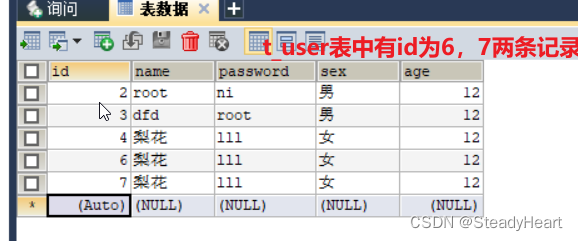
从以上现象可以看出,实现批量删除不能使用#{}的方式获取参数值,因为它会自动将参数值加上单引号,即会将delete from t_user where id in(#{ids}) 解析成delete from t_user where id in('5,6,7'); 只有id为5,6,7的数据会被删除
而批量删除正确的sql语句应该是:delete from t_user where id in(5,6,7);
所以批量删除只能用${}的方式获取参数值,它不会自动加单引号。
<!--int deleteUserByIds(@Param("ids")String ids);-->
<delete id="deleteUserByIds">
<!--错误:delete from t_user where id in(#{ids})-->
delete from t_user where id in(${ids})
</delete>执行结果:

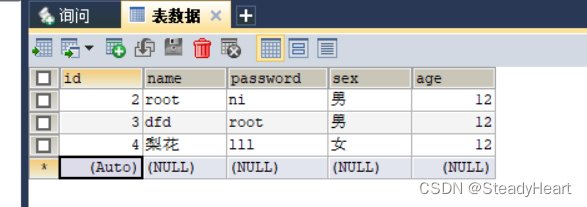
MyBatis根据动态的表名查询
/**
* 自定义要查询的表,根据传来的表名进行查询
*
* @param tableName
* @return
*/
List<User> getUserByTable(String tableName); <!--List<User> getUserByTable(String tableName);-->
<select id="getUserByTable" resultType="User">
select * from #{tableName}
</select> @Test
public void getUserByTableTest(){
SQLMapper mapper = SqlSessionUtil.getSqlSession().getMapper(SQLMapper.class);
List<User> users = mapper.getUserByTable("t_user");
System.out.println(users);
}运行结果:

可以看出来使用#{}的方式出错了,因为他会给要查询的表名加上单引号,
select * from 't_user';
而我们的表名是不能加单引号,所以这个也只能用${}的方式获取参数值。
<!--List<User> getUserByTable(String tableName);-->
<select id="getUserByTable" resultType="User">
<!--select * from #{tableName}-->
select * from ${tableName}
</select> 运行结果:
MyBatis获取自增的主键值
这个是干嘛的?
业务场景:
有一个班级信息表t_class(class_id,class_name);
有一个学生信息表t_student(student_id,stu_name,class_id);
1、要添加一个班级信息
2、获取新添加班级的主键值(MyBatis获取自增的主键值)
3、然后添加一个学生信息,同时指定学生所在的班级为刚刚添加的班级。(所以就需要获取刚刚添加班级的主键class_id)
使用:
/**
* 插入用户
*
* @param user
* @return
*/
int insertUser(User user); <!--
int insertUser(User user);
useGeneratedKeys属性:表明此sql语句是否使用了自动递增的主键
keyProperty属性:指定此sql语句执行完后产生的自动递增的主键值
将赋给传到此sql语句中参数的某个属性值
keyProperty="id",这里会赋值给传过来的参数User对象
-->
<insert id="insertUser" useGeneratedKeys="true" keyProperty="id">
insert into t_user values(null,#{username},#{password},#{sex},#{age})
</insert>
@Test
public void insertUserTest(){
SQLMapper mapper = SqlSessionUtil.getSqlSession().getMapper(SQLMapper.class);
User user = new User(null, "测试名", "234", "男", 23);
// 插入用户信息,id为空,但是表里面id字段是自增的,会将自增的id赋给user
int count = mapper.insertUser(user);
System.out.println(user);
}运行结果:


数据库表字段名和实体类属性名的映射
一对一映射
表:

对应实体类:
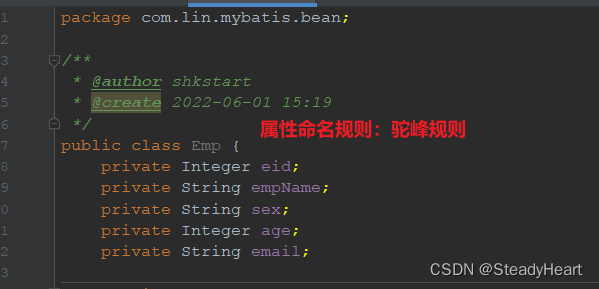
以下的查询sql,执行完毕后,会根据结果集中的字段名调对应的名字的属性名然后调该属性的set方法,将字段对应的值设置给属性。
<mapper namespace="com.lin.mybatis.mapper.EmpMapper">
<!--List<Emp> getAllEmp();-->
<select id="getAllEmp" resultType="Emp">
select * from t_emp
</select>
</mapper>问题引出,但是由于属性和字段的命名规则不一样,所以可能会出现以下情况:

问题解决,倘若字段名和属性名不一致,可以通过以下两种方式处理字段和属性之间的映射关系:
1、给查询的字段名其别名,这个别名要和属性名一样
<mapper namespace="com.lin.mybatis.mapper.EmpMapper">
<!--List<Emp> getAllEmp();-->
<select id="getAllEmp" resultType="Emp">
select eid,emp_name empName,sex,age,email,did from t_emp
</select>
</mapper>
2、在MyBatis核心配置文件中定义全局设置,
<settings>
<!--
mapUnderscoreToCamelCase:将下划线_自动映射为驼峰,默认值为false
如:emp_name==empName
-->
<setting name="mapUnderscoreToCamelCase" value="true"/>
</settings><mapper namespace="com.lin.mybatis.mapper.EmpMapper">
<!--List<Emp> getAllEmp();-->
<select id="getAllEmp" resultType="Emp">
<!--select eid,emp_name empName,sex,age,email,did from t_emp-->
select * from t_emp
</select>
</mapper>
3、使用resultMap自定义字段名和属性名的映射关系
<mapper namespace="com.lin.mybatis.mapper.EmpMapper">
<!--
resultMap:自定义结果集映射
id:映射id作为唯一标识
type:查询出来的结果集要映射的实体类类型
id:设置主键的映射关系
result:设置普通字段的映射关系
property:要映射的实体类中的属性名
column:要映射的结果集中的字段名,填查询出来的字段名
自我理解:
1.设置自定义映射后,MyBatis查询出结果集,会根据自定义映射关系,
找到 emp_name 对应的属性名empName将字段值赋给对应属性。
2.这种解决字段名和属性名不一致的方式一般比较少用的。
3.一般用来处理一对多和多对一。
-->
<resultMap id="empResultMap" type="Emp">
<id property="eid" column="eid"></id>
<result property="empName" column="emp_name"></result>
</resultMap>
<!--List<Emp> getAllEmp();-->
<select id="getAllEmp" resultMap="empResultMap">
select * from t_emp
</select>多对一映射
多个员工对应一个部门
业务背景:
想要查询员工的信息,
// 员工表t_emp对应的实体类
public class Emp {
private Integer eid;
private String empName;
private String sex;
private Integer age;
private String email;
private Dept dept;// 员工所在的部门
} /**
* 根据员工编号,查询所有的员工信息与其所在的部门信息
*
* @return
*/
Emp getEmpAndDeptById(@Param("eid")Integer eid); <!--Emp getEmpAndDeptById(@Param("eid")Integer eid);-->
<!--此时不能再用resultType了,因为查询出来的结果集的字段和实体类型的属性映射失败-->
<select id="getEmpAndDeptById" resultType="Emp">
select * from t_emp e left join t_dept d on e.did = d.did where eid = #{eid}
</select>查询结果集:

运行结果:
结果集的字段和实体类的属性映射失败,导致某些属性没有赋值。

解决方式一:使用自定义结果集映射resultMap解决上述问题(级联属性):
<!--应该使用自定义结果集映射resultMap-->
<!-- <select id="getEmpAndDeptById" resultType="Emp">-->
<select id="getEmpAndDeptById" resultMap="empAndDeptResultMap">
select * from t_emp e left join t_dept d on e.did = d.did where eid = #{eid}
</select>
<resultMap id="empAndDeptResultMap" type="Emp">
<id property="eid" column="eid"></id>
<result property="empName" column="emp_name"></result>
<result property="sex" column="sex"></result>
<result property="age" column="age"></result>
<result property="email" column="email"></result>
<result property="dept.did" column="did"></result>
<result property="dept.deptName" column="dept_name"></result>
</resultMap>MyBatis会根据自定义结果集映射将查询出来的结果集按照此套映射,将字段值设置给对应属性,比如:emp_name查询出来的值为 周杰伦,对应Emp的empName属性设置为 周杰伦;dept_name为B,对应Emp的dept的deptName设置为B。

解决方式二:在resulMap中使用association标签定义多对一映射关系
<!--
association:用于处理多对一的映射关系。如:多个字段映射一个dept属性
property:多对一的那个一,就是属性名
javaType:该属性的类型,可以使用别名
id:该类型的主键
result:该类型的其他属性
个人理解:MyBatis会根据javaType通过反射创建对象,然后通过反射给对应属性赋值,
最后将对象赋值给dept属性。
-->
<resultMap id="empAndDeptResultMap2" type="Emp">
<id property="eid" column="eid"></id>
<result property="empName" column="emp_name"></result>
<result property="sex" column="sex"></result>
<result property="age" column="age"></result>
<result property="email" column="email"></result>
<association property="dept" javaType="Dept">
<id property="did" column="did"></id>
<result property="deptName" column="dept_name"></result>
</association>
</resultMap>
<select id="getEmpAndDeptById" resultMap="empAndDeptResultMap2">
select * from t_emp e left join t_dept d on e.did = d.did where eid = #{eid}
</select>
@Test
public void getEmpAndDeptByIdTest(){
EmpMapper mapper = SqlSessionUtil.getSqlSession().getMapper(EmpMapper.class);
Emp emp = mapper.getEmpAndDeptById(2);
System.out.println(emp);
}调用Mapper接口中的方法,会执行getEmpAndDeptById这个sql语句,然后根据empAndDeptResultMap2映射关系,处理结果集和实体类型Emp之间的对应关系。
解决方式三:使用分步查询
某个字段使用其他的查询结果赋值。
/**
* 根据员工id查询员工信息
*
* @param eid
* @return
*/
Emp getEmpById(Integer eid); <!--Emp getEmpById(Integer eid);-->
<select id="getEmpById" resultMap="empResultMap2">
select * from t_emp where eid = #{eid}
</select>
<resultMap id="empResultMap2" type="Emp">
<result property="empName" column="emp_name"></result>
<!--
property="dept":要映射的对象是dept属性
select:查询语句,值就写sql语句的唯一表示(mapper.xml中的命名空间.sql语句id or Mapper接口全类名.方法名)
指明dept的属性值就是这个查询语句的结果
column:字段名,其对应的值作为select查询语句的条件。
-->
<association property="dept"
select="com.lin.mybatis.mapper.DeptMapper.getDeptById"
column="did">
</association>
</resultMap>查询部门:
<mapper namespace="com.lin.mybatis.mapper.DeptMapper">
<!--Dept getDeptById(Integer did);-->
<select id="getDeptById" resultMap="deptResultMap">
<!--此查询语句的条件就是需要一个部门编号id-->
select * from t_dept where did = #{did}
</select>
<resultMap id="deptResultMap" type="Dept">
<id property="did" column="did"></id>
<result property="deptName" column="dept_name"></result>
</resultMap>
</mapper>延迟加载
延迟加载:只根据所需的数据执行对应的sql语句,不会执行不相关的sql语句。倘若没有开启延迟加载的话,某些sql语句之间产生关联了,然后所需的数据只需要执行其中的一条sql语句即可,但是由于没有开启延迟加载,就得把这些关联的sql语句全部都执行,然后获取所需的数据。
分步查询的优点:可以实现延迟加载,但是必须在MyBatis核心配置文件中设置全局配置信息:
lazyLoadingEnabled:延迟加载的全局开关。当开启时,所有关联对象都会延迟加载。(默认为false)
aggressiveLazyLoading:当开启时,任何方法的调用都会加载该对象的所有属性。 否则,每个属性会按需加载。(默认为false)
<settings>
<!--开启全局延迟加载-->
<setting name="lazyLoadingEnabled" value="true"/>
<setting name="aggressiveLazyLoading" value="false"/>
</settings>以下就是分步查询的配置,查询员工信息dept,员工所对应的部门信息需要由另一条查询语句来查询部门信息。
<!--Emp getEmpById(Integer eid);-->
<select id="getEmpById" resultMap="empResultMap2">
select * from t_emp where eid = #{eid}
</select>
<resultMap id="empResultMap2" type="Emp">
<result property="empName" column="emp_name"></result>
<!--
分步查询:
dept属性的值由另一个查询语句的结果赋值。
property="dept":要映射的对象是dept属性
select:查询语句,值就写sql语句的唯一表示(mapper.xml中的命名空间.sql语句id or Mapper接口全类名.方法名)
指明dept的属性值就是这个查询语句的结果
column:字段名,其对应的值作为select查询语句的条件。
-->
<association property="dept"
select="com.lin.mybatis.mapper.DeptMapper.getDeptById"
column="did">
</association>
</resultMap>要员工的全部信息(包括部门信息):
@Test
public void getEmpByIdTest(){
EmpMapper mapper = SqlSessionUtil.getSqlSession().getMapper(EmpMapper.class);
Emp emp = mapper.getEmpById(4);
System.out.println(emp);
}查询员工的全部信息,所以需要查询员工对应的部门信息,所以将关联的查询部门信息的sql语句一起执行了。

只要员工的姓名信息:
@Test
public void getEmpByIdTest(){
EmpMapper mapper = SqlSessionUtil.getSqlSession().getMapper(EmpMapper.class);
Emp emp = mapper.getEmpById(4);
System.out.println(emp.getEmpName());
}从运行结果可以看出,只执行了查询员工信息的sql语句select * from t_emp where eid = ?
因为我们只需要员工的名字,所以不需要查询部门信息,因此延迟加载了互相关联的查询部门信息的sql语句。

只要员工的所在的部门信息
@Test
public void getEmpByIdTest(){
EmpMapper mapper = SqlSessionUtil.getSqlSession().getMapper(EmpMapper.class);
Emp emp = mapper.getEmpById(4);
System.out.println(emp.getEmpName());
System.out.println("-----------------");
System.out.println(emp.getDept());
}
fetchType:指定当前的查询是否使用延迟加载。(eager表示使用,lazy表示使用)
<!--Emp getEmpById(Integer eid);-->
<select id="getEmpById" resultMap="empResultMap2">
select * from t_emp where eid = #{eid}
</select>
<resultMap id="empResultMap2" type="Emp">
<result property="empName" column="emp_name"></result>
<!--
分步查询:
dept属性的值由另一个查询语句的结果赋值。
property="dept":要映射的对象是dept属性
select:查询语句,值就写sql语句的唯一表示(mapper.xml中的命名空间.sql语句id or Mapper接口全类名.方法名)
指明dept的属性值就是这个查询语句的结果
column:字段名,其对应的值作为select查询语句的条件。
fetchType:指定当前的查询是否使用延迟加载。(eager表示使用,lazy表示使用)
-->
<association property="dept"
select="com.lin.mybatis.mapper.DeptMapper.getDeptById"
column="did"
fetchType="eager">
</association>
</resultMap> @Test
public void getEmpByIdTest(){
EmpMapper mapper = SqlSessionUtil.getSqlSession().getMapper(EmpMapper.class);
Emp emp = mapper.getEmpById(4);
System.out.println(emp.getEmpName());
/* System.out.println("-----------------");
System.out.println(emp.getDept());*/
}可以看出没有延迟加载。

一对多映射
一个部门有多个员工。
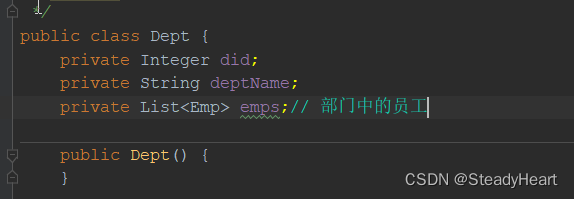
public interface DeptMapper {
/**
* 根据部门id查询部门信息
*
* @param did
* @return
*/
Dept getDeptById(Integer did);
}使用分步查询
<!--Dept getDeptById(Integer did);-->
<select id="getDeptById" resultMap="deptResultMap">
select * from t_dept where did = #{did}
</select>
<resultMap id="deptResultMap" type="Dept">
<id property="did" column="did"></id>
<result property="deptName" column="dept_name"></result>
<!--emps属性,需要使用多对一映射,需要使用另一条分步查询语句来赋值。
column是sql语句的条件所需的值-->
<association property="emps"
select="com.lin.mybatis.mapper.EmpMapper.getEmpsByDid"
column="did">
</association>
</resultMap>emps属性需要由以下的sql语句来查询并赋值:
<!--List<Emp> getEmpsByDid(Integer did);-->
<select id="getEmpsByDid" resultType="Emp">
select * from t_emp where did = #{did}
</select>用一条sql语句完成查询
<!--Dept getDeptById2(Integer did);-->
<select id="getDeptById2" resultMap="deptResultMap2">
select * from t_dept d left join t_emp e
on d.did = e.did where d.did = #{did}
</select>
<!--
collection:用来处理属性是集合的映射关系,处理一对多的映射关系(一个Emp对应几个字段)
ofType:指明集合中元素的类型,好使用反射调用属性设置,
-->
<resultMap id="deptResultMap2" type="Dept">
<result property="deptName" column="dept_name"></result>
<collection property="emps" ofType="Emp">
<id property="eid" column="eid"></id>
<result property="empName" column="emp_name"></result>
<result property="sex" column="sex"></result>
<result property="age" column="age"></result>
<result property="email" column="email"></result>
</collection>
</resultMap>

MyBatis实现动态SQL
if标签
在我们的平时业务中,常常要用到多条件查询。
比如查询一个员工的信息,要根据用户填写的信息来查询,要根据员工的姓名、性别、年龄、邮箱等信息来查询员工信息。
public interface DynamicSqlMapper {
/**
* 根据员工的姓名、性别、年龄、邮箱等信息来查询员工信息。
*
* 将员工的姓名、性别、年龄、邮箱等信息封装成一个员工对象作为参数
*
* @param emp
* @return
*/
List<Emp> getEmpByConditions(Emp emp);
}
<mapper namespace="com.lin.mybatis.mapper.DynamicSqlMapper">
<!--List<Emp> getEmpByConditions(Emp emp);-->
<!--
if标签:是mybatis中提供的,其中test属性可以填传递过来的数据
只有test属性为真,
if标签体中的内容才会被拼接到上面的sql语句(select * from t_emp where)中
-->
<select id="getEmpByConditions" resultType="Emp">
select * from t_emp where
<if test="empName != null and empName != ''">
emp_name = #{empName}
</if>
<if test="sex != null and sex != ''">
and sex = #{sex}
</if>
<if test="age != null and age != ''">
and age = #{age}
</if>
<if test="email != null and email != ''">
and email = #{email}
</if>
</select>
</mapper> @Test
public void getEmpByConditionsTest(){
DynamicSqlMapper mapper = SqlSessionUtil.getSqlSession().getMapper(DynamicSqlMapper.class);
// 用户可能在前端输入了要查询的员工信息
// 然后后端,获取请求参数,获取要查询的员工信息
String empName = "易烊千玺";
int age = 21;
String sex = "男";
Emp emp = new Emp(null, empName, sex, age, null);
List<Emp> empList = mapper.getEmpByConditions(emp);
System.out.println(empList);
}
也有可能只输入了性别和年龄:
@Test
public void getEmpByConditionsTest(){
DynamicSqlMapper mapper = SqlSessionUtil.getSqlSession().getMapper(DynamicSqlMapper.class);
// 用户可能在前端输入了要查询的员工信息
// 然后后端,获取请求参数,获取要查询的员工信息
// 也有可能只输入了年龄和性别
Emp emp2 = new Emp(null, null, "男", 21, null);
List<Emp> empList = mapper.getEmpByConditions(emp2);
System.out.println(empList);
}
修改映射文件:
<mapper namespace="com.lin.mybatis.mapper.DynamicSqlMapper">
<!--List<Emp> getEmpByConditions(Emp emp);-->
<!--
if标签:是mybatis中提供的,其中test属性可以填传递过来的数据
只有test属性为真,if标签体中的内容才会被拼接到上面的sql语句(select * from t_emp where)中
1=1是恒成立条件,不影响查询结果,又可以防止empName为null,可以和sql语句一起拼接
-->
<select id="getEmpByConditions" resultType="Emp">
select * from t_emp where 1=1
<if test="empName != null and empName != ''">
emp_name = #{empName}
</if>
<if test="sex != null and sex != ''">
and sex = #{sex}
</if>
<if test="age != null and age != ''">
and age = #{age}
</if>
<if test="email != null and email != ''">
and email = #{email}
</if>
</select>
</mapper>
where标签
上面的if标签,我们可以看到where关键字是写死的,那么如果下面的if标签都不成立,那么where关键字就很多余。
基于以上问题引出where标签:
1、where标签一般和if标签一起使用
2、如果where标签中有内容(就是if标签成立)则会自动生成WHERE关键字和上面的sql语句拼接,而且会将最前面的and或or关键字去除掉。
3、如果where标签中没有内容(if标签都不成立),则不会生成WHERE关键字,体现动态性。
<select id="getEmpByConditions" resultType="Emp">
select * from t_emp
<where>
<if test="empName != null and empName != ''">
emp_name = #{empName}
</if>
<if test="sex != null and sex != ''">
and sex = #{sex}
</if>
<if test="age != null and age != ''">
and age = #{age}
</if>
<if test="email != null and email != ''">
and email = #{email}
</if>
</where>
</select>
trim标签
trim用于去掉或添加标签中的内容
常用属性
prefix:在trim标签中的内容的前面添加某些内容
- suffix:在trim标签中的内容的后面添加某些内容
- prefixOverrides:在trim标签中的内容的前面去掉某些内容
- suffixOverrides:在trim标签中的内容的后面去掉某些内容
若trim中的标签都不满足条件,则trim标签没有任何效果,也就是只剩下
select * from t_emp
<select id="getEmpByConditions" resultType="Emp">
select * from t_emp
<trim prefix="where" suffixOverrides="and">
<if test="empName != null and empName != ''">
emp_name = #{empName} and
</if>
<if test="sex != null and sex != ''">
sex = #{sex} and
</if>
<if test="age != null and age != ''">
age = #{age} and
</if>
<if test="email != null and email != ''">
email = #{email}
</if>
</trim>
</select>
choose、when、otherwise一套标签
choose、when、otherwise相当于if...else if..else或者switch case default1.when至少要有一个,otherwise至多只有一个
2.when只会执行一个,如果有多个when都成立,那么谁在前面执行谁的
3.when都不成立的话,则执行otherwise中的
@Test
public void getEmpByConditionsTest(){
DynamicSqlMapper mapper = SqlSessionUtil.getSqlSession().getMapper(DynamicSqlMapper.class);
// 用户可能在前端输入了要查询的员工信息
// 然后后端,获取请求参数,获取要查询的员工信息
// 也有可能只输入了年龄和性别
Emp emp2 = new Emp(null, null, "男", 21, null);
List<Emp> empList = mapper.getEmpByConditions(emp2);
System.out.println(empList);
}<!--
choose、when、otherwise相当于if...else if..else或者switch case default
1.when至少要有一个,otherwise至多只有一个
2.when只会执行一个,如果有多个when都成立,那么谁在前面执行谁的
-->
<select id="getEmpByConditions" resultType="Emp">
select * from t_emp
<where>
<choose>
<when test="empName != null and empName != ''">
emp_name = #{empName}
</when>
<when test="sex != null and sex != ''">
sex = #{sex}
</when>
<when test="age != null and age != ''">
age = #{age}
</when>
<when test="email != null and email != ''">
email = #{email}
</when>
<otherwise>
did = 1
</otherwise>
</choose>
</where>
</select>
foreach循环遍历
foreach循环遍历输出,主要帮我们实现一些批量操作。
- collection:要遍历的集合或数组
- item:给集合或数组中的每一项元素起个变量名,代表集合或数组中的每一项元素
- separator:指明遍历输出的每一项数据之间的分隔符
- open:指明以什么开始遍历输出,设置foreach标签中的内容的开始符
- close:指明以什么结束遍历输出,设置foreach标签中的内容的结束符
foreach实现批量删除
/**
* 根据员工编号id构成的数组来删除员工
*
* @Param("eids") 到时候,mybatis会以@param注释的值为键,然后参数数组为值.
*
* @param eids
* @return
*/
int deleteEmpByEids(@Param("eids") Integer[] eids); <!--int deleteEmpByEids(Integer[] eids);-->
<delete id="deleteEmpByEids">
delete from t_emp where eid in
(
<foreach collection="eids" item="eid" separator=",">
#{eid}
</foreach>
)
</delete> <!--int deleteEmpByEids(Integer[] eids);-->
<delete id="deleteEmpByEids">
delete from t_emp where eid in
<foreach collection="eids" item="eid" separator="," open="(" close=")">
#{eid}
</foreach>
</delete> @Test
public void deleteEmpByEidsTest(){
DynamicSqlMapper mapper = SqlSessionUtil.getSqlSession().getMapper(DynamicSqlMapper.class);
int count = mapper.deleteEmpByEids(new Integer[]{6, 7, 8});
System.out.println(count);
}<foreach collection="eids" item="eid" separator="," open="(" close=")"> #{eid} </foreach>这一整个foreach标签,最后遍历输出的就是:(6,7,8)

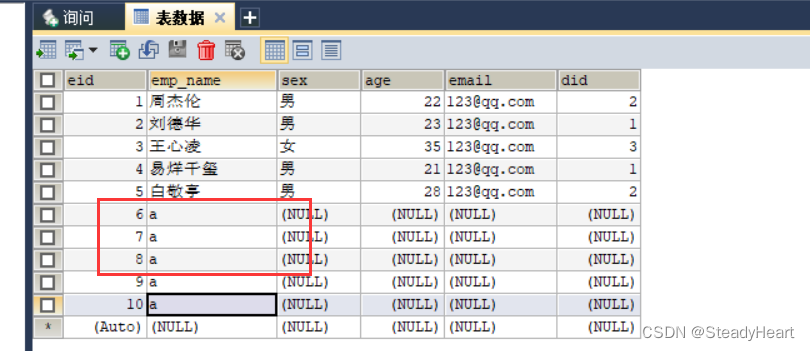
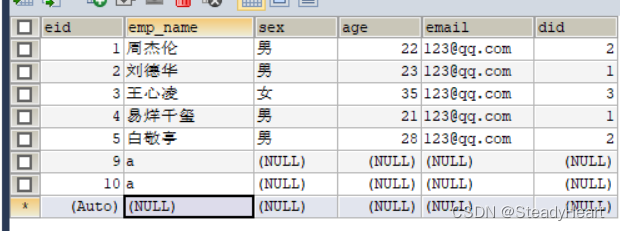
foreach实现批量添加
/**
* 批量添加员工
*@Param("empList") 到时候, mybatis会会将empList集合添加到Map集合中,
* 以@param注释的值为键,然后参数数组为值.
*
* @param empList
* @return
*/
int addEmpsByList(@Param("empList") List<Emp> empList); <!--int addEmpsByList(List<Emp> empList);-->
<!--insert into t_emp values(null,ename,sex,age,email,null),(null,ename,sex,age,email,null);-->
<insert id="addEmpsByList">
insert into t_emp values
<foreach collection="empList" item="emp" separator=",">
(null,#{emp.empName},#{emp.sex},#{emp.age},#{emp.email},null)
</foreach>
</insert>
@Test
public void addEmpsByListTest(){
DynamicSqlMapper mapper = SqlSessionUtil.getSqlSession().getMapper(DynamicSqlMapper.class);
// 要添加的员工集合
List<Emp> empList = new ArrayList<>();
empList.add(new Emp(null,"a","男",12,"234@qq.com"));
empList.add(new Emp(null,"b","男",23,"234@qq.com"));
empList.add(new Emp(null,"c","男",25,"234@qq.com"));
int count = mapper.addEmpsByList(empList);
System.out.println(count);
}
SQL标签
sql片段,可以记录保存一段公共sql片段,在使用的地方通过include标签进行引入
<sql id="empColumns">emp_name,sex,age,email</sql>
<select id="getEmpByConditions" resultType="Emp">
<!--select emp_name,sex,age,email from t_emp-->
select <include refid="empColumns"></include> from t_empMyBatis缓存
- 缓存只针对我们的查询功能
- MyBatis会将查询的数据缓存起来,如果下次查询的数据有在缓存中,则直接从缓存中获取,没有的话才去数据库查询,减少了JDBC的操作。
MyBatis的一级缓存
一级缓存是默认开启的。
一级缓存是SqlSession级别的,通过一个SqlSession查询的数据会被缓存,下次在同一个SqlSession中查询相同的数据,就会从缓存中直接获取,不会从数据库重新访问
一级缓存的范围就是要保证在同一个SqlSession中才行。
使一级缓存失效的四种情况:
1. 不同的SqlSession对应不同的一级缓存
2. 同一个SqlSession但是查询条件不同
3. 同一个SqlSession两次查询期间执行了任何一次增删改操作,不管有没有影响到查询的数据,任何一次增删改操作MyBatis都会去清空一级缓存。
4. 同一个SqlSession两次查询期间手动清空了缓存,代码:SqlSession.clearCache();
public interface CacheMapper {
/**
*
* @param eid
* @return
*/
Emp getEmpByEid(Integer eid);
}<mapper namespace="com.lin.mybatis.mapper.CacheMapper">
<!--Emp getEmpByEid(Integer eid);-->
<select id="getEmpByEid" resultType="Emp">
select * from t_emp where eid = #{eid}
</select>
</mapper>同一个sqlSession:
@Test
public void testCache1(){
// 一个sqlSession
SqlSession sqlSession = SqlSessionUtil.getSqlSession();
CacheMapper mapper1 = sqlSession.getMapper(CacheMapper.class);
Emp emp1 = mapper1.getEmpByEid(1);
System.out.println(emp1);
CacheMapper mapper2 = sqlSession.getMapper(CacheMapper.class);
Emp emp2 = mapper2.getEmpByEid(1);
System.out.println(emp2);
}

不同一个sqlSession:
@Test
public void testCache2(){
// 两个sqlSession
SqlSession sqlSession1 = SqlSessionUtil.getSqlSession();
SqlSession sqlSession2 = SqlSessionUtil.getSqlSession();
CacheMapper mapper1 = sqlSession1.getMapper(CacheMapper.class);
Emp emp1 = mapper1.getEmpByEid(1);
System.out.println(emp1);
CacheMapper mapper2 = sqlSession2.getMapper(CacheMapper.class);
Emp emp2 = mapper2.getEmpByEid(1);
System.out.println(emp2);
}
MyBatis的二级缓存
二级缓存是SqlSessionFactory(可以理解为一个数据库连接池)级别,通过一个SqlSessionFactory创建的SqlSession查询的结果会被缓存;后面再通过同一个SqlSessionFactory创建的SqlSession进行查询,会从二级缓存中找,如果有相同的查询,则直接从缓存中取,没有则访问数据库;此后若再次执行相同的查询语句,结果就会从缓存中获取
二级缓存开启的条件
1. 在核心配置文件中,设置全局配置属性cacheEnabled="true",默认为true,不需要设置
2. 在映射文件中设置标签<cache />
3. 二级缓存必须在SqlSession关闭或提交之后有效,只有Sqlsession关闭或提交之后,查询的数据才会被保存到二级缓存中,否则保存到一级缓存中。
4. 查询的数据所转换的实体类类型必须实现序列化的接口。比如查询员工共信息,那么员工类就必须implement Serializable只有满足以上四个条件,二级缓存才能生效。
二级缓存的相关配置
在mapper配置文件中添加的cache标签可以设置一些属性
eviction属性:缓存回收策略
LRU(Least Recently Used) – 最近最少使用的:移除最长时间不被使用的对象。
FIFO(First in First out) – 先进先出:按对象进入缓存的顺序来移除他们。
SOFT – 软引用:移除基于垃圾回收器状态和软引用规则的对象。
WEAK – 弱引用:更积极地移除基于垃圾收集器状态和弱引用规则的对象。
默认的是 LRU
flushInterval属性:刷新间隔,就是清空缓存的时间间隔,单位毫秒
默认情况是不设置,也就是没有刷新间隔,缓存仅仅调用语句(增删改)时刷新清空缓存。
size属性:引用数目,正整数
代表缓存最多可以存储多少个对象,太大容易导致内存溢出
readOnly属性:只读,true/false
true:只读缓存;会给所有调用者返回缓存对象的相同实例。因此这些对象不能被修改。这提供了很重要的性能优势。速度快。
false:读写缓存;会返回缓存对象的拷贝(通过序列化)。这会慢一些,但是安全,因此默认是false
MyBatis缓存查询的顺序
先查询二级缓存,因为二级缓存中可能会有其他程序已经查出来的数据,可以拿来直接使用
如果二级缓存没有命中,再查询一级缓存
如果一级缓存也没有命中,则查询数据库
SqlSession关闭之后,一级缓存中的数据会写入二级缓存
整合第三方缓存EHCache(了解)
由于我们的MyBatis是一个持久层框架,所以它在做缓存功能可能没有那么专业,所以我们可以用第三方的缓存来替换MyBatis的二级缓存,但是一级缓存是替换不了的。
第一步:添加依赖
<!-- Mybatis EHCache整合包 -->
<dependency>
<groupId>org.mybatis.caches</groupId>
<artifactId>mybatis-ehcache</artifactId>
<version>1.2.1</version>
</dependency>
<!-- slf4j日志门面的一个具体实现 -->
<dependency>
<groupId>ch.qos.logback</groupId>
<artifactId>logback-classic</artifactId>
<version>1.2.3</version>
</dependency>各个jar包的功能:
| jar包名称 | 作用 |
|---|---|
| mybatis-ehcache | Mybatis和EHCache的整合包 |
| ehcache | EHCache核心包 |
| slf4j-api | SLF4J日志门面包 |
| logback-classic | 支持SLF4J门面接口的一个具体实现 |
第二步:创建EHCache的配置文件ehcache.xml
名字必须叫`ehcache.xml`
<?xml version="1.0" encoding="utf-8" ?>
<ehcache xmlns:xsi="http://www.w3.org/2001/XMLSchema-instance"
xsi:noNamespaceSchemaLocation="../config/ehcache.xsd">
<!-- 磁盘保存路径 -->
<diskStore path="D:\atguigu\ehcache"/>
<defaultCache
maxElementsInMemory="1000"
maxElementsOnDisk="10000000"
eternal="false"
overflowToDisk="true"
timeToIdleSeconds="120"
timeToLiveSeconds="120"
diskExpiryThreadIntervalSeconds="120"
memoryStoreEvictionPolicy="LRU">
</defaultCache>
</ehcache>第三步:设置二级缓存的类型
-
在xxxMapper.xml文件中设置二级缓存类型
<cache type="org.mybatis.caches.ehcache.EhcacheCache"/>第四步:加入logback日志
-
存在SLF4J时,作为简易日志的log4j将失效,此时我们需要借助SLF4J的具体实现logback来打印日志。创建logback的配置文件
logback.xml,名字固定,不可改变
<?xml version="1.0" encoding="UTF-8"?>
<configuration debug="true">
<!-- 指定日志输出的位置 -->
<appender name="STDOUT"
class="ch.qos.logback.core.ConsoleAppender">
<encoder>
<!-- 日志输出的格式 -->
<!-- 按照顺序分别是:时间、日志级别、线程名称、打印日志的类、日志主体内容、换行 -->
<pattern>[%d{HH:mm:ss.SSS}] [%-5level] [%thread] [%logger] [%msg]%n</pattern>
</encoder>
</appender>
<!-- 设置全局日志级别。日志级别按顺序分别是:DEBUG、INFO、WARN、ERROR -->
<!-- 指定任何一个日志级别都只打印当前级别和后面级别的日志。 -->
<root level="DEBUG">
<!-- 指定打印日志的appender,这里通过“STDOUT”引用了前面配置的appender -->
<appender-ref ref="STDOUT" />
</root>
<!-- 根据特殊需求指定局部日志级别 -->
<logger name="com.atguigu.crowd.mapper" level="DEBUG"/>
</configuration>EHCache配置文件说明
| 属性名 | 是否必须 | 作用 |
|---|---|---|
| maxElementsInMemory | 是 | 在内存中缓存的element的最大数目 |
| maxElementsOnDisk | 是 | 在磁盘上缓存的element的最大数目,若是0表示无穷大 |
| eternal | 是 | 设定缓存的elements是否永远不过期。 如果为true,则缓存的数据始终有效, 如果为false那么还要根据timeToIdleSeconds、timeToLiveSeconds判断 |
| overflowToDisk | 是 | 设定当内存缓存溢出的时候是否将过期的element缓存到磁盘上 |
| timeToIdleSeconds | 否 | 当缓存在EhCache中的数据前后两次访问的时间超过timeToIdleSeconds的属性取值时, 这些数据便会删除,默认值是0,也就是可闲置时间无穷大 |
| timeToLiveSeconds | 否 | 缓存element的有效生命期,默认是0.,也就是element存活时间无穷大 |
| diskSpoolBufferSizeMB | 否 | DiskStore(磁盘缓存)的缓存区大小。默认是30MB。每个Cache都应该有自己的一个缓冲区 |
| diskPersistent | 否 | 在VM重启的时候是否启用磁盘保存EhCache中的数据,默认是false |
| diskExpiryThreadIntervalSeconds | 否 | 磁盘缓存的清理线程运行间隔,默认是120秒。每个120s, 相应的线程会进行一次EhCache中数据的清理工作 |
| memoryStoreEvictionPolicy | 否 | 当内存缓存达到最大,有新的element加入的时候, 移除缓存中element的策略。 默认是LRU(最近最少使用),可选的有LFU(最不常使用)和FIFO(先进先出 |
MyBatis的逆向工程
正向工程:先创建Java实体类,由框架负责根据实体类生成数据库表。Hibernate是支持正向工程的
逆向工程:先创建数据库表,由框架负责根据数据库中的表,反向生成如下资源:
Java实体类
Mapper接口
Mapper映射文件
创建逆向工程的步骤
第一步:在项目下创建一个Maven模块

第二步:在Maven模块的pom.xml文件中添加依赖和插件
<!--打包方式-->
<packaging>jar</packaging><dependencies>
<!-- MyBatis核心依赖包 -->
<dependency>
<groupId>org.mybatis</groupId>
<artifactId>mybatis</artifactId>
<version>3.5.9</version>
</dependency>
<!-- junit测试 -->
<dependency>
<groupId>junit</groupId>
<artifactId>junit</artifactId>
<version>4.13.2</version>
<scope>test</scope>
</dependency>
<!-- MySQL驱动 -->
<dependency>
<groupId>mysql</groupId>
<artifactId>mysql-connector-java</artifactId>
<version>8.0.27</version>
</dependency>
<!-- log4j日志 -->
<dependency>
<groupId>log4j</groupId>
<artifactId>log4j</artifactId>
<version>1.2.17</version>
</dependency>
</dependencies>
<!-- 控制Maven在构建过程中相关配置 -->
<build>
<!-- 构建过程中用到的插件 -->
<plugins>
<!-- 具体插件,逆向工程的操作是以构建过程中插件形式出现的 -->
<plugin>
<groupId>org.mybatis.generator</groupId>
<artifactId>mybatis-generator-maven-plugin</artifactId>
<version>1.3.0</version>
<!-- 插件的依赖 -->
<dependencies>
<!-- 逆向工程的核心依赖 -->
<dependency>
<groupId>org.mybatis.generator</groupId>
<artifactId>mybatis-generator-core</artifactId>
<version>1.3.2</version>
</dependency>
<!-- 数据库连接池 -->
<dependency>
<groupId>com.mchange</groupId>
<artifactId>c3p0</artifactId>
<version>0.9.2</version>
</dependency>
<!-- MySQL驱动 -->
<dependency>
<groupId>mysql</groupId>
<artifactId>mysql-connector-java</artifactId>
<version>8.0.27</version>
</dependency>
</dependencies>
</plugin>
</plugins>
</build>第三步:创建MyBatis的核心配置文件
<?xml version="1.0" encoding="UTF-8" ?>
<!DOCTYPE configuration
PUBLIC "-//mybatis.org//DTD Config 3.0//EN"
"http://mybatis.org/dtd/mybatis-3-config.dtd">
<configuration>
<properties resource="jdbc.properties"/>
<typeAliases>
<package name=""/>
</typeAliases>
<environments default="development">
<environment id="development">
<transactionManager type="JDBC"/>
<dataSource type="POOLED">
<property name="driver" value="${jdbc.driver}"/>
<property name="url" value="${jdbc.url}"/>
<property name="username" value="${jdbc.username}"/>
<property name="password" value="${jdbc.password}"/>
</dataSource>
</environment>
</environments>
<mappers>
<package name=""/>
</mappers>
</configuration>第四步:创建逆向工程所需的配置文件
-
文件名必须是:
generatorConfig.xml
<?xml version="1.0" encoding="UTF-8"?>
<!DOCTYPE generatorConfiguration
PUBLIC "-//mybatis.org//DTD MyBatis Generator Configuration 1.0//EN"
"http://mybatis.org/dtd/mybatis-generator-config_1_0.dtd">
<generatorConfiguration>
<!--
targetRuntime: 执行生成的逆向工程的版本
MyBatis3Simple: 生成基本的CRUD(清新简洁版)
MyBatis3: 生成带条件的CRUD(奢华尊享版)
-->
<context id="DB2Tables" targetRuntime="MyBatis3Simple">
<!-- 数据库的连接信息 -->
<!-- 逆向工程要根据数据库中的表生成 -->
<jdbcConnection driverClass="com.mysql.cj.jdbc.Driver"
connectionURL="jdbc:mysql://localhost:3306/mybatis"
userId="root"
password="123456">
</jdbcConnection>
<!-- javaBean的生成策略-->
<!--
targetPackage:javabean生成的包名
targetProject:javabean生成的位置
.\src\main\java当前模块下的src。。。
enableSubPackages:能否生成子包,true表示可以,false则com.lin.mybatis.bean表示一个目录
trimStrings:是否去除字段中的前后空格,要根据字段名生成JavaBean的属性名
-->
<javaModelGenerator targetPackage="com.lin.mybatis.bean" targetProject=".\src\main\java">
<property name="enableSubPackages" value="true" />
<property name="trimStrings" value="true" />
</javaModelGenerator>
<!-- SQL映射文件的生成策略 -->
<sqlMapGenerator targetPackage="com.lin.mybatis.mapper"
targetProject=".\src\main\resources">
<property name="enableSubPackages" value="true" />
</sqlMapGenerator>
<!-- Mapper接口的生成策略 -->
<javaClientGenerator type="XMLMAPPER"
targetPackage="com.lin.mybatis.mapper" targetProject=".\src\main\java">
<property name="enableSubPackages" value="true" />
</javaClientGenerator>
<!-- 指明数据库中要逆向分析的表 -->
<!-- tableName设置为*号,可以对应所有表,此时不写domainObjectName -->
<!-- domainObjectName属性指定生成出来的实体类的类名 -->
<table tableName="t_emp" domainObjectName="Emp"/>
<table tableName="t_dept" domainObjectName="Dept"/>
</context>
</generatorConfiguration>第五步:执行插件的generate目标进行逆向工程生成
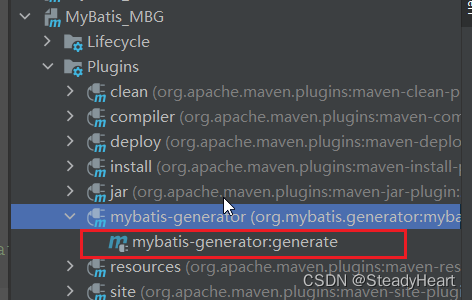
看到以下说明成功了:
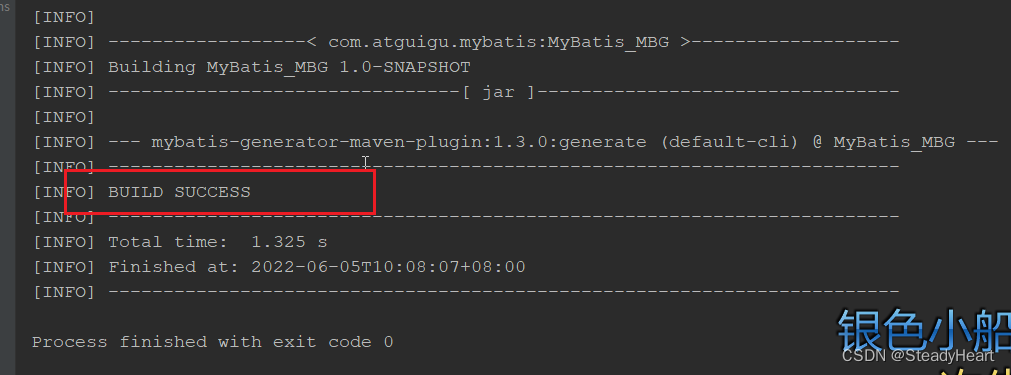
如果出现报错:Exception getting JDBC Driver,可能是pom.xml中,数据库驱动配置错误
那你就要检查pom.xml文件中的dependencies标签中的mysql驱动要和mybatis-generator-maven-plugin插件中的mysql驱动的版本是否一致

奢华尊享版的逆向工程功能测试
selectByExample:按条件查询,需要传入一个example对象或者null;如果传入一个null,则表示没有条件,也就是查询所有数据
example.createCriteria().andXXX:创建条件对象,通过andXXX方法为SQL添加查询添加,每个条件之间是and关系
example.or().andXXX:将之前添加的条件通过or拼接其他条件
测试查询:
// 测试查询功能
@Test
public void testMBGOfQuery1() throws IOException {
InputStream is = Resources.getResourceAsStream("mybatis-config.xml");
SqlSessionFactory sqlSessionFactory = new SqlSessionFactoryBuilder().build(is);
SqlSession sqlSession = sqlSessionFactory.openSession(true);
EmpMapper mapper = sqlSession.getMapper(EmpMapper.class);
// 查询所有的员工信息
List<Emp> empList = mapper.selectByExample(null);// 传入null表示条件为null即没有条件,就是查询所有的员工
empList.forEach(emp -> System.out.println(emp));
}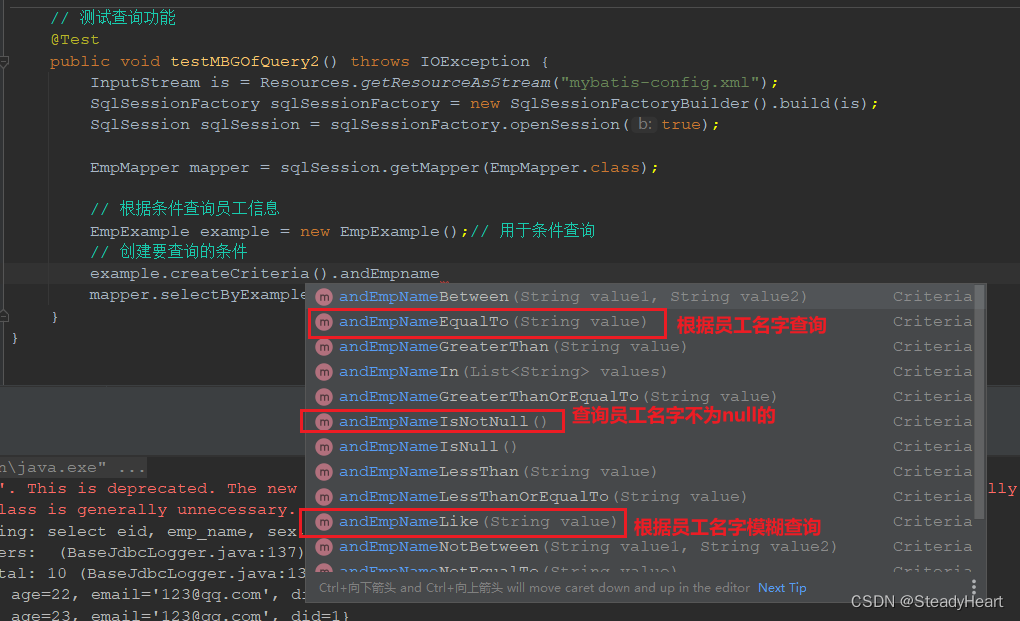

代码:
// 测试查询功能
@Test
public void testMBGOfQuery2() throws IOException {
InputStream is = Resources.getResourceAsStream("mybatis-config.xml");
SqlSessionFactory sqlSessionFactory = new SqlSessionFactoryBuilder().build(is);
SqlSession sqlSession = sqlSessionFactory.openSession(true);
EmpMapper mapper = sqlSession.getMapper(EmpMapper.class);
// 根据条件查询员工信息
EmpExample example = new EmpExample();// 用于条件查询
// 创建要查询的条件
// 1.这是添加与and条件
example.createCriteria().andEmpNameEqualTo("易烊千玺").andAgeGreaterThanOrEqualTo(10);
// 2.这是添加或or条件
example.or().andEmpNameEqualTo("周杰伦");
List<Emp> empList = mapper.selectByExample(example);
for (Emp emp : empList) {
System.out.println(emp);
}
}
测试修改:
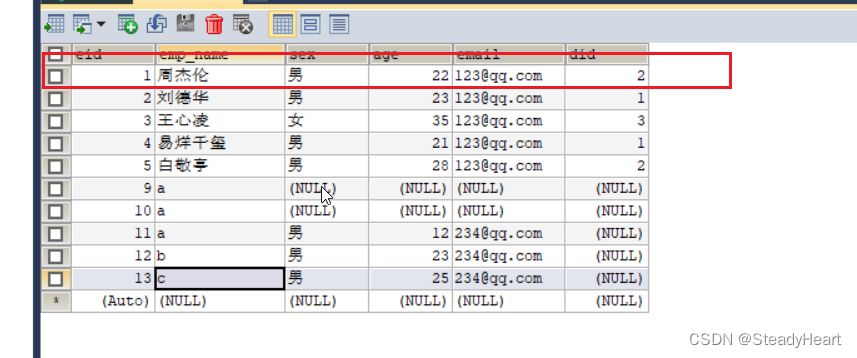
普通修改:
// 测试修改功能
@Test
public void testMBGOfUpdate1() throws IOException {
InputStream is = Resources.getResourceAsStream("mybatis-config.xml");
SqlSessionFactory sqlSessionFactory = new SqlSessionFactoryBuilder().build(is);
SqlSession sqlSession = sqlSessionFactory.openSession(true);
EmpMapper mapper = sqlSession.getMapper(EmpMapper.class);
// updateByPrimaryKey()方法是普通的根据主键修改记录信息,如果其中有空的字段的话,还是会修改成null
int count = mapper.updateByPrimaryKey(new Emp(1, "周杰伦", "男", null, "jay@qq.com", 5));
System.out.println(count);
}
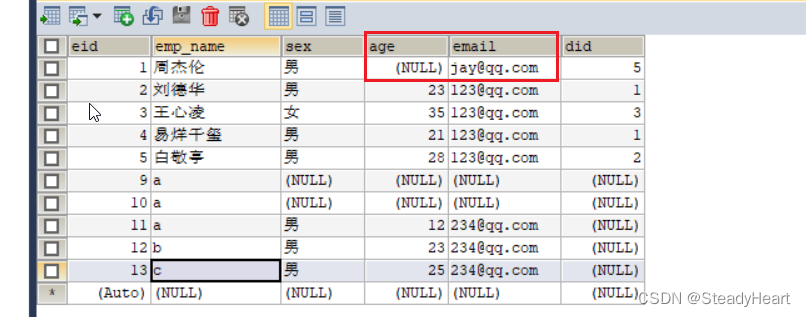
选择性修改:
// 测试修改功能
@Test
public void testMBGOfUpdate2() throws IOException {
InputStream is = Resources.getResourceAsStream("mybatis-config.xml");
SqlSessionFactory sqlSessionFactory = new SqlSessionFactoryBuilder().build(is);
SqlSession sqlSession = sqlSessionFactory.openSession(true);
EmpMapper mapper = sqlSession.getMapper(EmpMapper.class);
// updateByPrimaryKeySelective()方法是选择性的根据主键修改记录信息,如果其中有空的字段的话,则这个字段会被去除掉,不会修改为null
int count = mapper.updateByPrimaryKeySelective(new Emp(1, "周杰伦", "男", null, "zhou@qq.com", 5));
System.out.println(count);
}
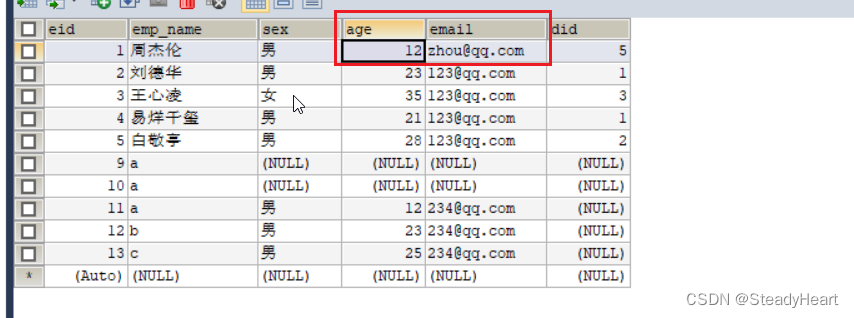
MyBatis使用分页插件
分页插件使用步骤
第一步:在pom.xml文件中添加依赖
<!-- https://mvnrepository.com/artifact/com.github.pagehelper/pagehelper -->
<dependency>
<groupId>com.github.pagehelper</groupId>
<artifactId>pagehelper</artifactId>
<version>5.2.0</version>
</dependency>第二步:在mybatis核心配置文件中配置分页插件
<plugins>
<!--设置分页插件-->
<plugin interceptor="com.github.pagehelper.PageInterceptor"></plugin>
</plugins>第三步:在查询之前开启分页功能
开启分页功能:PageHelper.startPage(int pageNum, int pageSize);pageNum是页码,pageSize是每页显示的记录数。
// 测试分页插件功能
@Test
public void testPage1() throws IOException {
InputStream is = Resources.getResourceAsStream("mybatis-config.xml");
SqlSessionFactory sqlSessionFactory = new SqlSessionFactoryBuilder().build(is);
SqlSession sqlSession = sqlSessionFactory.openSession(true);
EmpMapper mapper = sqlSession.getMapper(EmpMapper.class);
// 开启分页功能
PageHelper.startPage(1,4);
// 查询所有的员工信息
List<Emp> empList = mapper.selectByExample(null);// 传入null表示条件为null即没有条件,就是查询所有的员工
empList.forEach(emp -> System.out.println(emp));
}
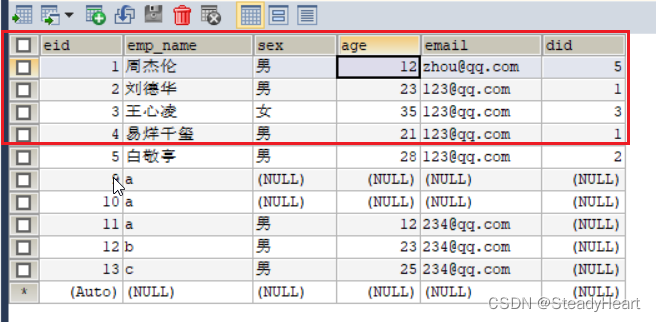
第四步:在查询完分页所需的数据之后,获取和分页相关的信息
在查询分页所需的数据,获取list集合之后,使用
PageInfo<T> pageInfo = new PageInfo<>(List<T> list, intnavigatePages)获取分页相关数据PageInfo对象包含了做分页功能相关的很多信息。
list:分页的数据
navigatePages:导航分页的页码数,就是分页导航条一次显示多少个页码
// 测试分页插件功能
@Test
public void testPage1() throws IOException {
InputStream is = Resources.getResourceAsStream("mybatis-config.xml");
SqlSessionFactory sqlSessionFactory = new SqlSessionFactoryBuilder().build(is);
SqlSession sqlSession = sqlSessionFactory.openSession(true);
EmpMapper mapper = sqlSession.getMapper(EmpMapper.class);
// 开启分页功能
PageHelper.startPage(3, 4);
// 查询所有的员工信息,这里会获取第三页然后每页4条的数据
List<Emp> empList = mapper.selectByExample(null);// 传入null表示条件为null即没有条件,就是查询所有的员工
empList.forEach(emp -> System.out.println(emp));
// 在查询完分页所需的数据后,获取和分页相关的信息(PageInfo包含了和分页功能相关的所有数据)
PageInfo<Emp> page = new PageInfo<>(empList,5);
System.out.println("-------page相关---------");
System.out.println(page);
}pageInfo:
常用数据:
pageNum:当前页的页码
pageSize:每页显示的条数
size:当前页显示的真实条数
total:总记录数
pages:总页数
prePage:上一页的页码
nextPage:下一页的页码
isFirstPage/isLastPage:是否为第一页/最后一页
hasPreviousPage/hasNextPage:是否存在上一页/下一页
navigatePages:导航分页的页码数
navigatepageNums:导航分页的页码,[1,2,3,4,5]
PageInfo{pageNum=3, pageSize=4, size=4, startRow=9, endRow=12, total=23, pages=6,
list=Page{count=true, pageNum=3, pageSize=4, startRow=8, endRow=12, total=23, pages=6, reasonable=false, pageSizeZero=false}[Emp{eid=12, empName='b', sex='男', age=23, email='234@qq.com', did=null}, Emp{eid=13, empName='c', sex='男', age=25, email='234@qq.com', did=null}, Emp{eid=14, empName='aa', sex='null', age=null, email='null', did=null}, Emp{eid=15, empName='aa', sex='null', age=null, email='null', did=null}],
prePage=2, nextPage=4, isFirstPage=false, isLastPage=false, hasPreviousPage=true, hasNextPage=true, navigatePages=5, navigateFirstPage=1, navigateLastPage=5, navigatepageNums=[1, 2, 3, 4, 5]}
Mybatis日志输出
mybatis提供了很多种日志功能:
- SLF4J
- LOG4J 【掌握】
- LOG4J2【Spring5要求掌握的】
- JDK_LOGGING
- COMMONS_LOGGING
- STDOUT_LOGGING【掌握】标准日志
- NO_LOGGING
mybatis中具体使用哪个日志,在mybatis的核心配置文件中设定。
依赖:
log4j.properties配置:
#log4j.rootLogger = level, appenderName1, appenderName2, …
#appenderName:就是指定日志信息要输出到哪里。可以同时指定多个输出目的地,用逗号隔开。console是输出到控制台
#level:DEBUG < INFO < WARN < ERROR < FATAL,只会输出大于等于该级别的日志信息
log4j.rootLogger=debug,console
#log4j.appender.appenderName1=className. console上面设置日志输出到哪,org.apache.log4j.ConsoleAppender表示控制台、org.apache.log4j.FileAppender表示文件
log4j.appender.console=org.apache.log4j.ConsoleAppender
#设置日志输出的格式。org.apache.log4j.PatternLayout表示可定制化、org.apache.log4j.SimpleLayout(包含日志信息的级别和信息字符串)
log4j.appender.console.layout=org.apache.log4j.PatternLayout
#ConversionPattern设置以怎样的格式输出日志信息。百度很多。
log4j.appender.console.layout.ConversionPattern=%d{HH:mm:ss,SSS} [%t] %p %C{1} : %m%n
#log4j.logger.全类名=level 自定义指定某个类中的日志输出级别
log4j.logger.org.apache.zookeeper=WARN
log4j.logger.org.apache.dubbo.config.bootstrap.DubboBootstrap=WARN
log4j.logger.com.lin.module1.Module1Application=INFO




 本文详细介绍了MyBatis框架的核心配置、映射文件、执行原理及各种应用场景,包括参数获取方式、多条件查询、动态SQL、缓存机制、逆向工程和分页插件等内容。
本文详细介绍了MyBatis框架的核心配置、映射文件、执行原理及各种应用场景,包括参数获取方式、多条件查询、动态SQL、缓存机制、逆向工程和分页插件等内容。
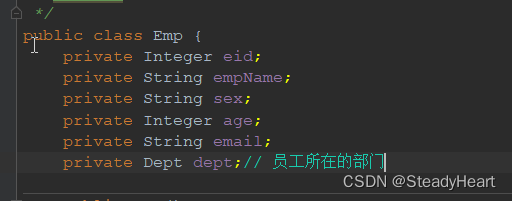

















 993
993

 被折叠的 条评论
为什么被折叠?
被折叠的 条评论
为什么被折叠?










